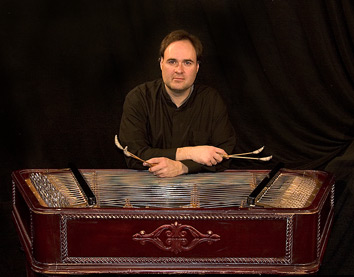A Brief History of the Cimbalom
 The "cimbalom", musical instrument of
the Hungarian Gypsies, may be traced back in history to the Orient and the
Middle East. An early known instrument in Arabia was called the "kannun" (or
qanun ), which was a musical soundbox with metal or gut strings strung across
one or two bridges. It was played by 'striking the strings with a pair of metal
mallets. The early Asiatic Nomads, especially the conquering invadors from
Mongolia and China, and the roaming Gypsies from India, carried the instrument
to all parts of Europe and the Middle East.
The "cimbalom", musical instrument of
the Hungarian Gypsies, may be traced back in history to the Orient and the
Middle East. An early known instrument in Arabia was called the "kannun" (or
qanun ), which was a musical soundbox with metal or gut strings strung across
one or two bridges. It was played by 'striking the strings with a pair of metal
mallets. The early Asiatic Nomads, especially the conquering invadors from
Mongolia and China, and the roaming Gypsies from India, carried the instrument
to all parts of Europe and the Middle East.
One of the first modifications of the kannun was the "psaltery" which became
extinct in history by later modifications invented by the people in the various
countries of Europe. Sizes and shapes varied and the manner of playing also
changed. In Greece, Turkey and Persia, the "santur" was developed; in Russia we
find the "gusli", in Germeny the "hackbrett", in Italy the "salterio", in
England, Ireland and America the"hammered dulcimer", in Austria the "Zither",
and in Hungary and Romania the "cimbalom". Most of these instruments are played
with a pair of sticks or mallets. The gusli and the zither are played by
plucking the strings (pizzicato), and resting the instrument on the players
lap.
The largest of these instruments is the cimbalom (also cymbalom, cembalom,
cymbalium and czimbalum). It is the national musical instrument of Hungary and
is used in the Classical and Folk Music as frequently as the piano.
It was first mentioned in Hungarian history about 720 A.D. In the 17th century
it was performed for the Emperor Ferdinand of Austria. In the 18th and 19th
Century it competed with the new keyboard instruments of the day -harpsichord
and clavichord - for popularity in middle Europe. In the middle of the last
century insufficient cimbaloms were being produced to meet the demands of the
times. In 1890 the cimbalom was nationalized as the instrument of Hungary. By
1897 it was added to the curriculum of the Budapest Academy of Music.
The cimbalom may be described as a 125 stringed instrument on a soundbox,
mounted on removable legs. Its tone is a cross between the piano and the harp
with a range of 4.5 to 5 octaves. The player creates tones by striking the
strings with 8-inch long wooden or metal mallets. It is played with two carved
wooden sticks about 8 inches long with the striking end wrapped with cotton,
wool or leather creating sounds that range from bright to very soft or the tips
of the mallets can be left bare, creating a sound similar to that of a banjo.
Two damper bars and a foot pedal help to control the sounding vibrations of the
cimbalom. The instrument stands about 3 feet high on its removable legs and
weighs about 150 to 200 pounds. The strings are like piano wires, but custom
made to fit the instrument. Music from classical to folk (gypsy) to jazz can be
heard on the cimbalom.
Information provided by Ms. Marlene Somsak, daughter of Bela
Somsak, maker of cimbaloms & a cimbalist
Edited by Richard Moore